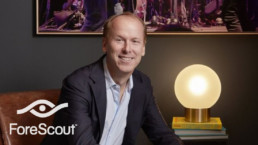Aspect Ventures Raises $181 Million Second Fund From Investors Including Melinda Gates
Four years after striking out from big-brand venture capital firms to set up their own shop, Theresia Gouw and Jennifer Fonstad are back for more with a second fund and several high-profile new supporters.
(Read on Forbes)
Aspect Ventures announced on Tuesday it has raised a $181 million second fund for investing in early-stage startups, this time with the backing of Melinda Gates and Cisco CEO Chuck Robbins. Aspect will look to build on investments such as ForeScout, a security company that went public in October, as well as early bets on companies such as networking startup Cato Networks, design marketplace Crew, security intelligence shop Exabeam and careers site The Muse.
The firm had announced the promotion of Lauren Kolodny, a 2016 Forbes 30 under 30 alumna, in December. Though Aspect's team has swelled to nine members, Gouw says that the firm will continue to focus on Series A and seed investments with its new fund at a similar size to its previous checks. "We wanted to be able to do two things, lead a Series A, but also be small enough that we can be collaborative," says Gouw.
With focuses on cyber security, digital health and the future of work so far, Aspect has established itself as a firm that plays nice with others. About half its deals from its first fund were introduced to the firm through co-investor peers, Gouw says. Some of Aspect's deals it has joined as an external investor providing a fair price to existing investors looking to add to their bets; in others such as many of its seed deals, the firm has typically participated alongside a seed funding specialist as a warm-up to a Series A. "The bumper crop of seed investors creates more opportunity for us," Gouw says.
Gouw and Fonstad raised their first fund on a track record that included long stays at Silicon Valley mainstays Accel Partners and Draper Fisher Jurvetson, at which the two combined for five IPOs, several dozen acquisitions and multiple billions of dollars in returns for investors. Aspect's second fund was raised, Gouw says, on the strength of the ForeScout exit and the higher valuations its other portfolio companies have reached, including Cato Networks, Crew, Exabeam and The Muse, as well as healthcare startup Vida and wellness video company Grokker.
Though it now includes five men on its investment team, Aspect Ventures is a rarity in tech as a venture capital firm founded by two women. Among its startups, 40% include a female cofounder, above the industry average, while half include an immigrant or first-generation citizen and about 30% a cofounder from a racial minority. Those numbers almost perfectly match against the Aspect investment team, which is 40% female, immigrant or first generation and minority background.
"We've seen that teams that are more diverse in tech have outperformed," says Gouw. "If everyone looks the same and goes to the same two or three schools, they'll have a lot of overlap. You look at Aspect, and there's probably a lot less overlap."
How Investors Like Melinda Gates Are Helping These VCs Tackle Tech’s Bro Problem
It could be just another monthly partner meeting at just another “Fill in the Blank” Capital, typical Silicon Valley–based venture firm. The fund’s top players sit around a white conference table, armed with Apple laptops and pastel-colored cans of La Croix.
(Read on Fortune)
A couple of startup entrepreneurs stop by to present to the partners, enthusing over upward-trending charts and touting the merits of recent hires. Outside the expansive windows lies the not-quite-bustling heart of downtown Palo Alto—a town that, along with nearby Menlo Park and the city of San Francisco, is a mecca for Arc’teryx vest–wearing VCs.
But anyone who knows this hub of venture capital would immediately spot something unusual about this particular gathering: Four of the eight investors seated around the table are female. And one of the two presenting portfolio company heads is also a woman. In Silicon Valley, where unicorns are a dime a dozen, this kind of gender ratio is the real rare and magical discovery.
“If you have more diversity you have better financial performance,” says Theresia Gouw, one-half of the founding team of Aspect Ventures, the norm-breaking VC firm at hand (the other founder is Jennifer Fonstad). “Our company is nearly 50/50 in an industry in which just 7% of investors are female. And our portfolio is a reflection of our pipeline.”
Gouw and Fonstad, both longtime VCs who worked at firms like Accel and DFJ, didn’t set out to create a “female-focused” fund when they launched Aspect in 2014. But they believed that diversity, both internally and throughout their portfolio companies, would lead to better outcomes—and they had the right Rolodex to test out their thesis. “We have different networks than the traditional firms on Sand Hill Road,” says Fonstad, referring to the nearby street where the bulk of the most established VCs are headquartered.
The results: Over the course of their careers, Gouw and Fonstad’s investments have resulted in a collective seven public offerings, 26 acquisitions, and more than 500 financing rounds in follow-on capital. Aspect, which is now announcing a second, larger fund with some big-name limited partners (more on that later), began with $150 million in financing and has already made 29 Series A investments. One of its portfolio companies, security startup ForeScout, went public last fall at a valuation of about $800 million. Other standout investments under Aspect’s first fund include Cato Networks and Exabeam, both promising cybersecurity startups; health-tech player Vida Health; and online career source The Muse.
Overall, women founders receive less than 3% of total VC dollars (women of color, meanwhile, get a meager 0.2%), but Aspect’s portfolio looks strikingly different from the norm: About 40% of the firm’s companies were founded by women, and 30% were started by minorities. Once, those numbers might have been a mere curiosity—today they are becoming a competitive advantage. While investing for diversity is something certain industry players have been pushing for a long time, the message is finally beginning to be received by the deep-pocketed individuals and institutions that fund the Silicon Valley ecosystem. Why? Ignoring it can be expensive.
Last summer, after six female founders accused venture capitalist Justin Caldbeck of making unwanted sexual advances, his firm, Binary Capital, spiraled downward fast. Caldbeck quickly resigned from the all-male firm. A new fund, then in the process of being raised by Binary, was abruptly halted.
It’s not just venture capital firms that can be impacted. Perhaps the most high-profile example of how such misconduct can destroy value is Uber, the ride-sharing company rocked by allegations of harassment and sexism early last year. A number of other embarrassing debacles followed—including reports that Uber had used a software tool to try to deceive authorities by “hiding” rides—and ultimately resulted in a more than 20% decrease to the once high-flying company’s valuation, from around $70 billion to an estimated $54 billion.”
There’s no foolproof method to guarantee that a VC shop or startup will be immune to these kinds of problems, but betting on diverse leaders can give investors some peace of mind. Numerous studies have suggested that gender-balanced teams drive better business results—and, perhaps unsurprisingly, research shows that male-dominated organizations have higher levels of sexual harassment than those with more equitable gender dynamics.
None of this is lost on anyone who has a stake in Silicon Valley’s success, let alone the limited partners who fund the entire ecosystem, a.k.a. the investors in the investors.
“In many ways, the venture and startup ecosystem is still a boys’ club—one that all too often excludes, disadvantages, and mistreats talented women who want to contribute to it,” says Melinda Gates, cochair of the Bill & Melinda Gates Foundation and an investor. “The data tells us that’s harmful to society and bad for business.”
Gates is one of a handful of limited partners who have put a collective $181 million into Aspect’s just-announced fund, the firm’s second. Another LP is Cisco Systems (CSCO, +0.96%), the Bay Area–based networking giant, whose financing arm invests directly in startups and in other funds. “This fiscal year was the first time that we have specifically put diversity into our [investment] planning,” says Janey Hoe, a vice president with Cisco Investments. “Just like I have a plan for security and collaboration and data center, we have now put forward a plan for [investing in] diversity.”
While there have long been small players in the venture capital community who defied the stats and were able to attract some LP money, they tended to be relegated to the fringes of the industry, with less access to sizable funds and the buzziest companies. Now, as Silicon Valley is finally coming to terms with the fact that bad behavior can do more than cause a temporary headache, concerned LPs are taking notice. That opens the door for funds like Aspect, which have made diversity part of their investment strategy from the get-go. The question now: Is this newish breed of VCs truly in a position to challenge the established firms that have long ruled Sand Hill Road? Or is this trend just another one of tech’s passing fads?
Even with the brawn of Gates and Cisco behind it, Aspect’s $181 million fund isn’t all that menacing to the status quo when compared with the Valley’s biggest names, many of whom raise single funds worth more than $1 billion. But if the powers behind the money start to reprioritize, we could see the balance begin to tip in the underdog’s direction. If there’s one thing VCs know all too well, it’s that little guys sometimes put the big guys out of business.
Until recently, LPs have largely stayed in the background, invisible to most who operate day to day in the tech world. But despite their often secretive nature, these wealthy individuals, offices of private family funds, or institutions hold immense power. And venture capitalists say they are starting to ask questions.
“They likely believe [claims of sexual harassment] are material information,” says Mike Maples Jr., cofounder of Floodgate, a Palo Alto–based VC firm with an investing team that’s 40% female. “In today’s world, if partners engage in unacceptable behavior the entire firm can blow up.”
Limited partners have done significant back-channel reference checking for years. But according to insiders, not only are LPs doing even more intensive vetting these days, but also the people they are talking to are now much more likely to feel a responsibility to out bad behavior. “Now there is more of a culture of people thinking, ‘Hey, you should talk about these things even if they are rumors,’ ” says Floodgate’s other cofounder, Ann Miura-Ko.
“This year and in 2017 it has definitely been a lot more top of mind for [LPs],” says Lan Xuezhao, the founding partner at Basis Set Ventures, a new, artificial intelligence–focused VC firm. The former Dropbox executive raised $140 million for her first fund and says that while bigger funds have a clear advantage when it comes to leading the largest deals, her dual focus—A.I. and diversity—gives her a leg up.
Even some of those larger funds appear to be feeling the pressure to diversify. Benchmark added its first-ever female partner last May, while Sequoia Capital hired its first female investing partner in the U.S. in fall of 2016. The moves brought the VC heavyweights to 17% and 11% women, respectively.
NEA, one of the largest firms with $20 billion in assets under management, has yet to hire or promote a female general partner, though it does have six female investing partners on staff. But Dayna Grayson, one of those investing partners, says her firm does have some advantages—besides just sheer dollars—over smaller players.
“When you get to a certain scale you can have an HR body, a chief legal officer, policies and training, and a number of other levers to ensure that everybody is informed” on what is and is not acceptable in the workplace, says Grayson. So while a firm like NEA may not have a woman at the table when the big decisions are being made, there is an argument that it can afford the infrastructure needed to stem bad behavior, both at its portfolio companies and within its own ranks.
Kate Barrett, NEA’s marketing partner, adds that comparing the gender ratios of large firms like hers with smaller players can be misleading: It’s one thing for a four-person firm to be 50% female, but quite another for a 36-person operation like NEA.
NEA maintains that questions about diversity have not impacted its fundraising. But that may well change. The firm closed its latest fund, a massive $3.3 billion, last May, just as the Valley’s harassment scandals were starting to mount—but before they gained real attention from the bulk of the tech world. “We hear from our LPs during fundraising times,” says Barrett.
Last September, about 200 representatives from some of the largest family funds in the country gathered at the Ritz-Carlton in San Francisco. The group comprised, as portfolio manager Kristen Koh Goldstein put it, the kind of people who are “wealthy enough they don’t need to be in a listicle.” But while the attendees might opt to keep their fortunes out of the press, they are putting those funds to work; everyone at the gathering was a limited partner, tasked with allocating large amounts of private, family-owned capital into various investments, including many of Silicon Valley’s venture capital firms.
Goldstein, who comanages the investments of her family office, AthenaPartners, had been asked by the gathering’s organizers to put together content on a topic of increasing concern to the LPs in attendance: the mounting discrimination and harassment problems in the tech world. “They realized this was an issue, but they didn’t know the extent of it or what you could do about it as a limited partner,” says Goldstein.
The Bay Area–based investor brought in founder Niniane Wang, who sold her startup last year and is now an engineering leader at Pokémon Go creator Niantic. Earlier in 2017 she was among the women who publicly accused Caldbeck, the former partner at Binary Capital, of sexual harassment.
“I gave them [the LPs] some actionable advice, like, don’t sign a nondisclosure agreement as part of your investment, and ask questions about how they [the VCs] treat diversity or whether or not they have a female partner,” says Wang.
According to Goldstein, Wang received a standing ovation, and both women were mobbed with questions and comments from the audience. The session was the highest rated at the event, and the organization has already asked Goldstein to come up with similar programming for future summits.
“There is an enormous risk here that some of these families weren’t even aware of,” says Goldstein. “Our goal was to reach these wealthy people, who sometimes have no idea they are funding misogynists, and give them practical things they can do to protect themselves.”
Following the event, Goldstein has fielded several calls from high-profile family offices, asking for her take on whether there might be a misconduct or other risk with some of their potential investments; she calls these “what’s the real deal here” calls.
Some LPs—ones who obviously haven’t signed NDAs with the venture capital firms they’ve funded—aren’t just using back channels to ask questions. Instead they are throwing off their usual role as silent partner and for the first time taking their concerns public.
Last summer, amidst the wave of harassment scandals, 500 Startups cofounder Dave McClure was accused of sexual misconduct. The eccentric general partner of the incubator and venture capital firm apologized and resigned from his role. In response to the revelations, some of his most high-profile LPs, including Mitch Kapor and Freada Kapor Klein, publicly expressed their outrage at his behavior—and the larger tech community’s role in enabling it.
“This is a culture that has been allowed to fester and to rot by enablers who refused to intervene when they witnessed inexcusable behavior or went to great lengths to avoid seeing it,” they said in a statement.
Many limited partners have signed NDAs and will probably continue to do so. And many more won’t speak out even if given the opportunity. But as awareness and concern reaches critical mass, it’s likely that a growing number of LPs will make their voices heard—if not with words, then with dollars. Down the road, that could have tangible impact on venture capital firms that are not evolving to meet current demands.
“I want to back the people best positioned to successfully invest in tomorrow’s groundbreaking ideas,” says Melinda Gates. “And they’re not always the people who successfully invested in yesterday’s.”
This is an updated version of an article that appears in the Feb. 1, 2018 issue of Fortune with the headline “Can These VCs Fix Tech’s Bro Problem?”
This Startup Will Pay You To Use Less Electricity
OhmConnect is creating “negawatts”: units of energy saved by people turning off their appliances.
(Read on Fast Company)
[Source Image: Artyustudio, Jeremy Perkins/Unsplash]
When a single homeowner decides to turn off her TV in the evening, the action barely registers on the electric grid. It’s one appliance in one home, out of millions. But when thousands of homeowners turn off their TVs, dim their lights, and do without their washing machines for an hour, well, then the collective impact can make a difference. Potentially it’s the difference between a grid that’s well managed and a grid that’s forced into using emergency power that’s expensive and polluting.
Since it was founded four years ago, OhmConnect has shown how aggregating the energy-saving actions of thousands of homes can add up to something worthwhile. The San Francisco startup has managed to sign up 290,000 customers for its hour-long “demand response” events, gathering small shifts in behavior into something larger and more meaningful. These days, several Californian utilities pay for its services, preferring what are called “negawatts” (units of power saved) to using their plants to generate actual kilowatts and megawatts of electricity.
“A lot of people use us as an excuse to unplug and play a board game with the family,” says Curtis Tongue, cofounder of the startup, giving an extra reason why people like to participate with Ohmconnect’s programs. But freedom from evening electronic stimulation probably isn’t the main driver. Instead, it’s probably the hard cash they get for doing it. In return for reducing their power consumption, its customers are rewarded with points that can be redeemed for dollars. Tongue says a small apartment participating once a week can make $40-$50 a year. A larger home with several power-hungry appliances can save up to $200 a year. “It’s nice pocket change,” he says.
Utilities have long asked their customers to help them balance supply and demand on their networks. But traditionally “demand response” (the technical term) has involved very large consumers. An aluminum smelter owner for instance might agree to shut down on a summer’s day to offset demand from people’s air conditioners. Tongue says the industry was initially skeptical about a consumer-facing demand management business. But gradually they’ve come around: Pacific Gas and Electric, Southern California Edison and San Diego Gas & Electric are all OhmConnect customers now.
OhmConnect monitors energy markets for spikes in power demand. When it sees that the grid is in need of some demand reduction, it sends out text messages to its user-base suggesting energy-saving actions–like doing without the washing machine for an hour. When users sign up for the service, they agree for OhmConnect to monitor their home’s smart meter to understand their historical power usage. The startup compares a home’s energy usage in a given “OhmHour” against the previous 10 weekdays or four weekend days. For instance, if a home is asked to save energy on a Wednesday, the baseline might be an average of their usage at the same time on the previous Tuesday, Monday, Friday, and Thursday.
Tongue says an increasing proportion of customers–up to 19% currently– choose to automate how they respond to requests. For example, they open access to their Nest thermostat to turn down the temperature slightly at the given hour, or they set their home Tesla charging station not to power up during the allotted period.
Persuading so many users to sign up and participate hasn’t been easy, says Tongue. But OhmConnect has gradually become more canny about how it nudges customers into co-operating. For one thing, it operates on a fully opt-out basis. Shortly before an OhmHour, customers receive a message asking whether they want to participate. In other words, you have to make a choice to say you won’t play ball, upping the likelihood that you will.
OhmConnect also plays on a powerful observation from the field of behavioral economics called “loss aversion.” That says that people are more likely to want to avoid losses than make gains. Messages before OhmHours are somewhat guilt-inducing, making it clear that a community of energy-savers is depending on you, the user, to do your bit. Similarly, when people forget to take part, or they opt-out, a message will make it clear that they’ve let down fellow users. Other techniques include deducting points from non-participants and increasing them for people who participate regularly and dependably.
Now that it’s established in California, OhmConnect sees opportunities to grow in other places, including Texas and Toronto, and possibly on the East Coast. The startup makes money by taking a 20% cut on the amounts utilities offer for energy savings. (Tongue won’t give actual dollar numbers or indicate whether the business is profitable yet.) The contract with San Diego Gas & Electric is for 4.5 megawatts of power flexibility on any 20-minute period. In four years, OhmConnect has saved California’s grid 100 megawatts in all, or the equivalent of two peaker plants that no longer need to be fired up in high-demand moments.
In a report last year, Grand View Research said the demand response market will be worth $35.9 billion by 2025, with the residential sector accounting for about a quarter of that. So there appears plenty of revenue for startups like OhmConnect to go after if it can continue persuading households to participate.
“Consumer awareness is a significant headwind,” Tongue says. “Most people are not aware in California that a company like OhmConnect actually pays out for saving energy. But we do see a lot of the market shifting to an energy sharing model instead of demand response on the commercial side.”
Venture Capital Is Broken. These Women Are Trying to Fix It
Female CEOs get a dismal 2.7 percent of all venture capital, the fuel for building fast-growth companies. Now armies of women are ditching Sand Hill Road and creating their own funding universe. (Photo Credit: Hanna Barczyk)
(Read on Inc)
All great revolutions begin with alcohol. That seems to be the consensus at 9 in the morning on a sunny Friday in August, when 100 women board Dandeana, a three-level, 110-foot yacht about to set sail from Los Angeles's Marina del Rey. Muffins and fruit are mostly ignored as a bartender pours mimosas for the boat's guests, a diverse collection of women that includes attorneys, business coaches, a nurse, a documentary filmmaker, and a grandmother-granddaughter team. In sunglasses and mostly low heels (this is a boat, after all), these women will spend the next three hours plotting to overthrow the boys' club that rules the Silicon Valley venture capital scene.
This particular coup is being hosted by Vicki Saunders, a ridiculously energetic five-time entrepreneur with a blond bob and oversize black glasses, who is also the founder of SheEO. SheEO is a startup that wants to use low-interest debt to fund the growth of women-led companies. Saunders's premise is that masses of women could become the major source of funding for the next generation of female entrepreneurs. Her math works like this: If 1,000 women in a city each invest $1,000, that's $1 million available for lending to 10 female-run companies. Ideally, she'll recruit women from 1,000 cities, participants will re-up every year, and they'll put the money back in as the loans are repaid. Saunders's big-picture calculation: a billion dollars going to 10,000 female entrepreneurs every year, in perpetuity.
The mimosa-sipping guests are intrigued. Chelsea Galicia, a 33-year-old nonprofit executive director in a black V-neck jumpsuit, likes the fact that SheEO might give her a chance to back socially responsible companies. "I have a very hard time investing in the stock market because those companies are ruining the environment," she says. Tara McColeman, a nutritionist, says when she was married and applied for a new credit card, her husband was automatically designated the primary cardholder. "We live in a patriarchal society--it's just that way," she says. "I think women do need to band together more."
That the vast majority of these women have never before invested in startups, says Saunders, doesn't hurt SheEO's premise--it's precisely the point. After years of working with entrepreneurs at accelerators where the goal was always to build a billion-dollar company, Saunders noticed that fewer than 20 percent of accepted participants were women. Yet, she says, "we get to profitability faster than men and are more capital efficient." Saunders, who spent much of her career building youth-related companies, had long resisted starting something gender-based. But by 2013, she felt she had no choice. "Everything is broken," she says, referring to women's fundraising options. "Why do we want investors who know lots about things that don't work for women?"
To see how broken it is, look at the statistics. While women start companies at twice the rate of men, female-founded companies get only 13 percent of the total angel financing available. According to a study by First Round Capital, companies with a woman on the founding team outperform their all-male peers by 63 percent. But when it comes to venture capital--often the speediest route to building a fast-growth company--women simply aren't getting funded. Female CEOs get only 2.7 percent of all venture funding, while women of color get virtually none: 0.2 percent.
The women who are committed to female entrepreneurs have given up waiting for the venture capital industry to change. In 1999, the portion of venture capital deals that went to a startup with a woman on the executive team was just 5 percent. It's taken nearly 20 years to increase that amount to 18 percent. It's no better when you look at the profession itself. In 1999, 10 percent of venture capitalists were women; today, their number has sunk to just 6 percent.
The idea that women should be funding other women is hardly new. In 2005, a group of mostly Wall Street women started Golden Seeds, declaring that it would make angel investments only in female-led companies. Dozens of other early-stage investment groups have since followed its pioneering lead. Aspect Ventures, for example, was launched by two women, and co-founder Theresia Gouw says the firm sees more female-led deals as a result. Aspect's portfolio is about 40 percent women. That of Broadway Angels, one of the highest-powered gatherings of women in Silicon Valley, is roughly 50 percent.
As empowering as this seems, each of these initiatives hits the same wall: The business model doesn't scale. Each investment partner can do only so many deals and sit on only so many boards. With few female VCs to begin with, there simply aren't enough women with the experience, connections, and desire to raise their own funds.
But what has become clearer in recent years is that there is a hunger among women who've never traditionally thought of themselves as investors. According to a 2014 study by the Kauffman Foundation and Hebrew University, it turns out that when a female entrepreneur tries to raise money on Kickstarter, she is 7 percentage points more likely to be funded than a man. Women aren't showing up on crowdfunding sites to back just any kind of business--they are specifically seeking out those with female founders. While an advantage of 7 percentage points doesn't sound huge, if that shift happened in the larger female fundraising universe, the impact would be radical.
SheEO's Saunders is part of a group of women now trying to channel that desire and pipeline of cash to an even larger pool. The money is undeniably out there: Women currently control 39 percent of the country's investable assets, some $11.2 trillion. About 70 percent of the massive intergenerational wealth transfer will soon go to women, who will inherit once from their parents and again from their husbands (women in the U.S. tend to outlive men by 4.8 years). "Women control a lot of capital," says Darya Allen-Attar, co-founder of the Women Founders Network. "Men connect their capital with power," she concedes. "We don't."
Rather than grow more professional investors, Saunders and her peers are now working to train armies of novice female investors at various levels of disposable income. Forget the sophisticated gatekeepers, they say. Let's open up the gates.
Pretending to be Men
For decades, female entrepreneurs have been told that, yes, they absolutely can get funded by high-profile angels and venture capitalists. They just need to start companies that can scale, improve their pitches, and work on their confidence. For more than a decade, Sharon Vosmek, as the CEO of Astia, encouraged female founders to do just that. The organization would help entrepreneurs finesse their pitches and decks, and then connect them to investors. "Our job was to source the best deals, and venture capitalists would fund them because it was a meritocracy," she says.
But as Vosmek and others learned, it was never that simple. The industry's problems with sexism and unconscious bias have been well documented. When female founders pitched a business idea designed to solve a female problem, it was unlikely there was ever a female VC in the room. Though male VCs should be able to evaluate the merit of any early-stage company on the basis of its business plan, market research, and leadership, they would often declare ignorance and go home and ask their wives about it. Vosmek says Sand Hill Road has "a comfort zone," and if you're not in it, "they just shut down."
In 2015, Fran Dunaway experienced this firsthand while trying to get seed funding for her company, TomboyX, which makes men's-style briefs for women. "You could just see their eyes glaze over," says Dunaway, who got her business idea after discovering that typical panties weren't comfortable for women in uniform. Dunaway, who eventually raised 90 percent of her $1 million seed round from female angels, is expecting her company to take in revenue of $3 million this year.
Even when there is a female investor at the table, female entrepreneurs still often face an uphill battle. Janet Gurwitch, co-founder of Laura Mercier Cosmetics and the only female operating partner at private equity firm Castanea Partners, remembers presenting Drybar to her male partners in 2011. Drybar is a place for women to get their hair blown out relatively quickly and cheaply. Gurwitch genuinely worried that, among other things, "six of the 11 [partners] have very little hair. They're going to tell me it's a low barrier to entry." She prevailed, partly by reminding them that Starbucks was once "a little coffee shop in Seattle." Today, Drybar has nearly 70 locations and $100 million in revenue. Says Astia's Vosmek: "I don't think [early] investors are going to be, for women, classic venture firms."
Blowing Open the Gates
Right now, the alternative funding universe for women is just being constructed. If there's anyone who's qualified to help design it, it's Trish Costello, the former CEO of Kauffman Fellows, a startup-financing leadership program. She spent 10 years working to increase the range of people pursuing venture capital as a career. "What we saw was a lot of women left the business," says Costello. "Even when they were highly successful in terms of their [return], they were often not fully integrated into the leadership of the funds."
Frustrated, in 2013, Costello left Kauffman to start Portfolia. Instead of trying to convert women into career investors, she's working to persuade them to make investing a serious sideline. Rather than restrict participation to the well-connected or seriously wealthy, anyone who plunks down $10,000 in a Portfolia fund--each of which invests in six to eight female-run companies--immediately becomes a Portfolia LP (limited partner). LPs get a front-row seat to the entire funding process: They can watch the entrepreneurs pitch online, ask founders questions, and talk to the fund leads about deal terms and due diligence.
Portfolia LPs like Peggy Northrop, herself an entrepreneur, say the experience has demystified investing. "One thing I had worried about with angel investing is you have to be really, really rich," says the co-founder of PaperQuilt, a collaborative storytelling platform. "This makes it something you can plug into and learn from. You can develop some confidence."
Meanwhile, Pipeline Angels' Natalia Oberti Noguera is providing newbie female investors with an even lower barrier to entry. In 2011, the nonprofit executive founded the New York City-based outfit to increase the number of angel investors who weren't white, straight, and male. Pipeline offers training for would-be angels, and so far, about 200 women have completed it. As part of that training, each has to invest at least $5,000 in a startup.
Proof that these more democratized approaches are making a dent will depend on whether the participants ultimately go on to invest elsewhere. "We're creating our own brand of women VCs who are not anything like those you would normally create on Sand Hill Road," says Portfolia's Costello.
The $7.7 Billion Stretch Ahead
The question looming over all this: How much money will it take, really, to level the playing field for female entrepreneurs?
With current rates of funding, to reach parity across just the angel and early-stage VC markets would require about $7.7 billion. To reach parity across all stages of venture capital would require about $50 billion. By Inc.'s count, there are currently about two dozen early-stage female-focused financing efforts, representing about $100 million in funding annually.
In other words: We're not even close.
To fill that gap will require an even broader movement. Women who have their savings parked in retirement funds or who donate to charity will need to be persuaded that putting a fraction of their money in a new business is worthwhile. "Your retirement fund is allocated into companies you have no window into," says Northrop, the Portfolia LP. "You could put just 1 percent of that into a company you care about."
Astia's Vosmek says nontraditional funders are another target. One entrepreneur she worked with ended up raising money from the business wing of the Grosvenor family, which historically has been led by the Duke of Westminster. "They've been investing for 1,200 years," says Vosmek. Now she is courting philanthropists interested in world-changing ideas. "We're pointing out that early-stage investing can look a lot like philanthropy," she says.
Of course, the risk tolerance of women who've never invested before has yet to be tested. A SheEO member might not think $1,000 is a lot until a company that SheEO funds is unable to repay it. Portfolia's Costello and Astia's Vosmek are trying to manage expectations accordingly, making it clear to their investors that they aren't trying to bet on the next unicorn. Their goal is to fund companies that are successful, whatever that might mean.
Back in L.A., Dandeana is about to return to port. SheEO's Saunders won't know until late fall how many of the women aboard will join her movement. Earlier this year, a SheEO pilot in Toronto persuaded 500 women to each fork over $1,000. By September, Saunders will have hit San Francisco and Denver. Getting to 996 more cities will require many years, and many more mimosas. But when one woman on the boat approaches Saunders with a question, she's reminded why the hustle will be worth it.
"Can I write you a check right now?" she asks.
Aspect Ventures Promotes Lauren Kolodny to Partner
Aspect’s first employee has risen to a new rank at the female-led firm.
At the age of 23, Lauren Kolodny was named Brown University’s youngest member of the board of trustees. During her time on the board, Ms. Kolodny met Theresia Gouw, then a partner at Accel Partners.
That meeting proved to be the launching point for Ms. Kolodny’s career in venture capital. When Ms. Gouw started Aspect Ventures in 2014, Ms. Kolodny was her first hire.
On Tuesday, the firm announced Ms. Kolodny has been promoted to partner.
Ms. Kolodny will be one of four partners at the firm, including Ms. Gouw, Jennifer Fonstad and Kendra Ragatz, who serves as an operating partner. Aspect Ventures is raising a second fund with a target of $175 million, according to the firm’s June filing with the Securities and Exchange Commission.
In the male-dominated venture industry, Aspect Ventures is one of only a handful of firms with an all-female partnership. Ms. Kolodny said there are some male members on the investing team that bring a diverse perspective, but she said it has been a privilege to work at a firm founded by women.
“I’m very aware of a lot of the dynamics in the industry,” Ms. Kolodny said. “I work in a very supportive culture in that sense.”
Ms. Kolodny’s investments as a principal have covered a broad range of sectors, from software-as-a-service companies addressing the future of work to financial services. She led or co-led Aspect’s investments in Troops, Gusto and TalkIQ.
Earlier Ms. Kolodny worked in product marketing at Google and at Cowboy Ventures. She also holds an M.B.A. and masters in sustainable design from Stanford University.
Investor Spotlight: Jennifer Fonstad & Theresia Gouw
Watch Sallie Krawcheck's interview with Aspect's Jennifer Fonstad & Theresia Gouw
(Watch on Vimeo)
Your Next Gig: Map the Streets for Self-Driving Cars
I went for a drive in San Francisco’s Mission District last month. It was late morning, and there wasn’t much traffic. As I wended my way through the side streets, I avoided a double-parked armored car and steered around construction sites. Though it might have seemed like an aimless outing, my brief sortie was anything but. Every centimeter I drove, every object I encountered, and even the double line I crossed to avoid the Brinks truck was being recorded by a device affixed across the top edge of the windshield, just above the rearview mirror.
(Read on Wired)
Soon, thousands of people might be installing those gadgets in their cars, hoping to make some extra bucks—and, in the process, contributing to the next great crowdsourced project: a ridiculously detailed and constantly updated map of the world’s roads, readable only by the vast swarm of self-driving cars that will populate our byways.
The device is made by a San Francisco-based startup called Mapper, which comes out of stealth today after a year of development. The company’s maps don’t resemble the classic gas station fold-outs, or even the ones made by Google or Apple that have supplanted them. They are meant for machines, not humans, and when you see them rendered, they are made up of glowing pixels where objects, lane markers, and traffic signals are delineated by rough shapes and tell-tale colors. These are the maps of the future, and allegedly the bedrock of a multi-billion-dollar market. Self-driving cars can’t operate without such maps.
“As humans, if we are blindfolded and dropped in a new place, we'll find our bearings—we have millions of years of common sense to help guide our awareness,” says Nikhil Naikal, Mapper’s CEO. “A machine, on the other hand, needs a large amount of up-to-date 3D map data to have foresight of what to expect around the corner. And that's exactly the kind of maps that we deliver.”
Currently, companies that are testing autonomous vehicles—such as Waymo (spun out of Google’s research division), Uber, General Motors, and others—have to make their own maps. It’s a painstaking process that requires people to drive vans equipped with sophisticated lidar (a combination of lasers and radar) equipment over designated roads in multiple passes to log every curb height, fire hydrant, and lane marking. As a result, those vehicles are virtually fenced in by the pre-mapped region; a Waymo car’s self-driving mode won’t even kick in unless it senses that it’s in a mapped zone.
Mapper’s solution is to create an army of part-time workers to gather data that will accrue to a huge “base map” for autonomous cars, and to update the map to keep it current. Think of the work as an alternative to driving for Uber and Lyft, without having to deal with customer ratings or backseat outbursts from Travis Kalanick.
The key to Mapper’s scheme is that it can create high-definition 3D maps without using lidar. That expensive and sometimes finicky combination of lasers and radar has become the standard not only for piloting autonomous cars, but also for producing the cartography that grounds them. Mapper’s founders are PhD engineers who have participated in DARPA challenges and created an indoor mapping startup, Flyby Media (bought by Apple), and the company believes it can match lidar-quality results by relying on sophisticated modeling and data-compression techniques that allow it to use over-the-counter parts to snare data.
The company has created a femur-sized plastic device called the S1, which has multiple cameras and sensors that goes over one’s dashboard and a single cable connecting it to the cigarette lighter for power. It wirelessly syncs with a driver’s iPhone. “It cost $350 to make, it’s composed of commodity parts, and it is designed so it can be easily installed in any car,” says Naikal. After installation, the Mapper app directs the driver to a predetermined route and tells him or her how quickly to go. More accurately, how slowly to go—Naikal says the optimal velocity for a mapping session is between 10 and 30 miles an hour. (Mapper might consider issuing drivers bumper stickers identifying why those cars are creeping.)
Mapper doesn’t expect its drivers to work full time; Naikal says that more than four hours following the exacting directions from the app results in “cognitive overload.” Ideally, his drivers will use the app for an hour or two at a time. In addition, when not taking directions from the app, drivers can leave the system on, and Mapper will collect the data from wherever they wander. (This passive mode also pays, but much less.) “This can be anyone who wants to have a side hustle, who wants to make a little bit of money on the side,” says Naikal. “It could be construction workers; it could be people that are just out on the street a lot, who want to have an ability to do something cool and get paid to do it.”
Because a lot of the value that Mapper provides lies in updating the map—city streets might need refreshing at least once a week to reflect construction, new traffic patterns, and even grass growing higher—the work will be consistent. Mapper’s chief product officer, Jonathan Glanz, estimates that when the company scales up, it will be able to maintain its base map with about 10 thousand mappers—far fewer than Uber’s hundreds of thousands. “We won’t need a humongous fleet because we can select the tasks for mapping,” says Alonso Patron, Mapper’s chief technology officer.
Once it creates the base map and keeps updating it—“like a living organism,” says Naikal—Mapper can license the product to customers such as automakers, transportation services like Uber, and even technology companies like Apple and Waymo. What all of those customers have in common is that they are currently paying to do their own mapping, and would have to spend a lot more money for complete coverage. And, Naikal says, they are reluctant to share data with each other—why would Toyota trust Ford’s data? If you had one map—and evolved it using contracted drivers and other data submitted by the customers themselves—it would be like the Intel Inside of 3D maps, the standard digital atlas for the autonomous vehicles that will be our future chauffeurs. If companies want to customize that map for their needs, Mapper will accommodate them. “We want to have one base map,” Naikal says. “We focus on building that core base layer ourselves, owning the data, making it available for all.” When customers have specific needs they can send their own data to Mapper, which can layer it on top of its base map.
After testing the system in Old Alexandria, Virginia, earlier in the year, Mapper is now busily doing a digital Mason-Dixon on San Francisco, hoping to finish a base map of the city by Thanksgiving. The mapping will move to other cities over the next 14 months and then expand to urban centers overseas. After that, the company will turn to rural areas, eventually hoping to capture everything, so that autonomous cars will have a data cushion wherever they roam.
Once Mapper develops its base map, it can make money not only from the autonomous car manufacturers but also from other customers who might make use of the world’s most detailed guide to roadways: utilities maintaining infrastructure, insurance companies looking for hazards, and, perhaps most intriguing of all, augmented reality ventures that might want to transform your road trip with a stream of personalized billboards. (As for privacy issues, Mapper says that it’s not going to collect information like license numbers or house addresses, though its customers may well do so on proprietary layers they develop on top of the Mapper base map.)
“We feel that there might be use cases that we aren't even aware of,” says Naikal.
Mapper isn’t the only company with these ambitions. Like a sudden traffic jam on 101, a swarm of competitors has popped into the 3D mapping world, each with its own approach but all hoping to become Rand McNally for robots. “It’s a pretty crowded space,” says James Wu, CEO of DeepMap, which has raised $32 million in funding from primo VCs such as Andreessen Horowitz and Accel. (Mapper won’t reveal its funding, except to specify that none of it comes from potential customers.) Wu’s company also uses crowdsourcing as one of its data-collecting tactics.
A Y Combinator company from this year’s winter batch, Lvl5, also offers drivers some pocket change for mapping—in this case, simply attaching their phones to the dashboard and using the built-in cameras to capture data. Lvl5 CEO Andrew Kouri, who formerly worked for Tesla, says that if he sends enough drivers down a road, after 6 to 12 passes, Lvl5 will have good enough info to use its algorithms to add to the map. It pays drivers between one and five cents a mile, but doesn’t send them on pre-selected routes. “We use a lot of Uber drivers,” says Kouri.
Another company, Civil Maps, uses a relatively costly roof-mounted collection device so that developers in the field can contribute to its crowdsourced base map. (Ford is a funder.) Carmera, whose mission is to “democratize autonomous vehicle data,” partners with companies that operate fleets of cars or trucks. And one of the most formidable players is HERE, the spinoff from the broken pieces of Nokia. It has created a platform called Sensoris that accepts data from multiple partners.
Each of these companies hopes to land in a winner’s circle that might be big enough for only one. Mapper believes it has the unique combination of scale and quality to win. “Obviously it’s in everyone’s best interest to have one player who does this,” says Lvl5’s Kouri. Right now, it’s hard to gauge who’s got the inside track. All are scrambling to snare major customers, particularly automakers. I spoke to an executive at one major potential customer who is considering a pilot project with Mapper. “It’s hard to use cameras to do the work of lidar, but it comes down to expertise and history,” he says. “I don’t know if anyone else can do what the Mapper guys can do. Early results say they can do it.”
If a base map is adopted by Detroit, why wouldn’t the tech companies themselves sign on? For instance, Waymo says that for now its mapping is tied to development, but once its systems mature, it may well consider outsourcing the work.
But while it’s uncertain which company might emerge as the mapmaker who defines the world for machines, it does appear that we all might wind up contributing to it. Though Mapper’s founders don’t say it directly, those 10,000 part-timers who rack up a few bucks following the company’s exacting instructions will dwindle when Mapper starts making use of the built-in, road-facing cameras that will inevitably be standard equipment in the cars of the near future. Essentially, we will all have the technology to perform the functions of Mapper’s S1 windshield device—and these might be turned on by default, so we’ll do the work for free.
To fill in areas that aren’t reliably covered by camera-equipped cars, Mapper could still use contractors to follow its routes and ignore the impatient motorists who tailgate them. And when the era of autonomous cars does arrive, they can be dispatched to perfectly follow Mapper’s directions. No matter who is collecting the data, the robots will get their maps.
IoT-focused cybersecurity startup ForeScout files for initial public offering
“Internet of things”-focused cybersecurity firm ForeScout Inc. is going public.
The company announced Monday that it had filed its paperwork with the U.S. Securities and Exchange Commission for an initial public offering.
(Read on SiliconAngle)
The number of shares to be offered in the IPO and their price are described as having “not yet been determined,” though the company did say it was looking to raise $100 million, a common placeholder figure.
Founded in 2000, ForeScout offers a cybersecurity service that allows enterprises to see all sorts of devices the instant they connect to the network. The company’s platform integrates with leading network, security, mobility and information technology management products to allow users to control devices when they are connected to the network and orchestrate information sharing and operation among various different types of security tools to accelerate incident response.
“We have pioneered an agentless approach to network security to protect organizations against the emerging threats that exploit the billions of devices connected to organizations’ networks,” the company said in its S-1 filing. “The traditional approach of relying on a corporate-installed software agent to secure a device has significant limitations in today’s world as devices are developed using a wide variety of platforms and operating systems that cannot support agents.”
By the numbers, ForeScout reported revenue of $166.8 million in 2016, up from $126 million in 2015, showing continued growth with revenue of $90.6 million for the first six months of 2017. Still, losses have continued to grow as well, with the company reporting losses of $27.3 million in 2015, $74.8 million in 2016 and $47.7 million to July 31 this year.
ForeScout last took venture capital in January 2016, when it raised $76 million, and it has raised about $156 million to date. Previous investors include Accel Partners, Amadeus Capital Partners, Aspect Ventures, BCS Growth Fund, Cross Creek Advisors, Founders Circle Capital, ITOCHU Corp., Meritech Capital Partners, Oxx. Pitango Venture Capital and Wellington Management.
As of its last round, the company was described as having a valuation of “$1 billion or more.” Although the valuation for the IPO has not been disclosed, it would be fair to guess that it won’t be lower than that. A date has not been set. ForeScout will list on the NASDAQ under the stock symbol “FSCT.”
Morgan Stanley & Co. LLC, J.P. Morgan Securities LLC, and Citigroup Global Markets Inc. are acting as lead book runners, with BofA Merrill Lynch and UBS Securities LLC assisting.
Chime Announces $18 Million Series B to Accelerate Growth; Surpasses 500,000 Bank Accounts
Chime, the leader in mobile banking that helps members avoid fees and automate their finances, today announces $18 million in Series B financing, led by global venture fund Cathay Innovation. With over 500,000 bank accounts opened since the company's 2014 launch, this latest round of financing will be used to accelerate growth and to develop new products to improve financial lives.
(Read on Business Insider)
"At Cathay, we look at fintech investment opportunities across the globe and we've never seen so much customer love for a banking service," said Denis Barrier, Co-Founder and CEO of Cathay Innovation. "Chime members engage with the app every day and trust Chime as the deposit account for their paycheck. It's much more than just a mobile app. With triple digit growth in new bank account openings in the last year, Chime has emerged as the clear leader in the US challenger banking segment."
Cathay Innovation led the round from its $320 million venture fund and offers a global investment network bridging North America, Europe and China. Other new investors in the round include Northwestern Mutual Future Ventures and Omidyar Network which invested through their Financial Inclusion initiative. Existing investors Crosslink Capital, Aspect Ventures, Forerunner Ventures and Homebrew also participated in the round bringing Chime's total funding to $36MM.
"Look at any of the headlines these days and it's clear that traditional US banks continue to fail millions of Americans with adversarial practices and opaque fee structures," said Chris Britt, CEO and Founder of Chime. "This financing allows us to rapidly scale a new approach to mobile banking that actually improves financial lives."
Chime's Bank Fee Finder exposed the impact of traditional banks' predatory practices and found that on average bank customers pay $329 in fees annually. By eliminating overdrafts, Chime has saved its members an estimated $100MM in potential overdraft fees to date. Chime has also helped members increase their savings. While the majority of Americans have less than $500 in savings according to Bankrate, members who enrolled in Chime's automatic savings program have tripled their average monthly savings.
In addition to investing in growth, the company will use this latest round of funding to launch new features to help members automate more aspects of their financial lives. Chime will also introduce new services through its open APIs and partnerships with leading financial companies, so that members can use their Chime account as a connected hub to manage all of their financial accounts.
How 'the invisible network' poses a major security threat
Imagine a hacker remotely turning off a life support machine in a hospital, or shutting down a power station. These are the nightmare scenarios we face because many organisations haven't a clue how many unsecured devices are connected to their networks, cyber-security experts warn.
(Read post on BBC News)
It was an ordinary day at a busy hospital - doctors, nurses and surgeons rushed about attending to the health of their patients.
For Hussein Syed, chief information security officer for the largest health provider in New Jersey, it was the health of his IT network that was keeping him busy.
And today, he was in for a surprise.
He knew he presided over a complex web of connected medical devices, computers, and software applications spread across RWJBarnabas Health's 13 hospitals.
This included about 30,000 computers, 300 apps, a data centre, as well as all the mobile phones hooking up to the hospitals' wi-fi networks.
Company mergers had only added to the complexity of these sprawling IT systems.
But when he used a specialist IoT cyber-security program to carry out a full audit, he discovered that there were in fact 70,000 internet-enabled devices accessing the health firm's network - far more than he'd expected.
"We found a lot of things we were not aware of," Mr Syed tells the BBC, "systems that weren't registered with IT and which didn't meet our security standards."
These included security cameras and seemingly innocuous gadgets such as uninterruptible power supplies (UPSs) - units that provide back-up battery power in the event of a power cut.
"These unidentified devices could definitely have been access points for hackers who could have then found high-value assets on our network," says Mr Syed.
Hack in to a UPS and you could potentially switch off life-critical machines, he explains. Or hackers could steal patient data, encrypt it, then demand a ransom for its safe return.
On the black market "health data is worth 50 times more than credit card data", says Mr Syed.
The audit "helped us protect our network," he adds, preferring not to dwell on what might have been.
Mike DeCesare, chief executive of ForeScout, the software provider Mr Syed brought in, says: "Businesses typically underestimate by 30% to 40% how many devices are linked to their network. It's often a shock when they find out.
"With the proliferation of IoT [internet of things] devices the attack surface for hackers has increased massively.
"Traditional antivirus software was designed on the assumption that there were just a few operating systems. Now, because of IoT, there are thousands."
ForeScout's software monitors a company's network and indentifies every device trying to access it, "not just from its IP [internet protocol] address, but from 50 other attributes and fingerprints", says Mr DeCesare.
The reason for these other layers of security is that it is "relatively easy" for hackers to mask the identity of a particular device - known as MAC [media access control] spoofing.
So ForeScout's software takes a behavioural approach to monitoring.
"We look at the traffic from all those different devices and analyse whether they are behaving like they should," he says.
"Is that printer behaving like a printer? So why is it trying to access other devices on the network and break in to the system?
"If we spot aberrant behaviour we can disconnect the device from the network automatically."
Services from network monitoring firms - ForeScout, Solar Winds, IBM, SecureWorks, Gigamon and others - are becoming increasingly necessary in a world where everything - from lamp-posts to lawn sensors - is becoming internet-enabled.
According to Verizon's latest State of the Market: Internet of Things report there are now 8.4 billion connected devices - a 31% increase on 2016 - and $2tn (£1.5tn) will have been spent on the technologies by the end of 2017.
But as Verizon points out, lack of industry-wide standards for IoT devices is giving businesses major security concerns.
Stories of cyber-attacks mounted on the back of insecure devices such as video cameras have highlighted the issue.
"IoT security is one of the biggest challenges we're facing right now," says Darren Thomson, chief technology officer and vice president, technology services at cyber-security firm Symantec.
The difficulty is that IoT devices are generally simple, cheap and low-powered, without the capability of running the antivirus programs operated by traditional computers.
"The challenge with critical infrastructure is that it wasn't built with security in mind," says Tom Reilly, chief executive of Cloudera, the IoT and data analytics platform.
"Smart cities are a great playing field for hackers - changing traffic lights, turning elevators on and off - there are many security exposures.
"We need to get ahead of them."
This necessitates a different approach to security, a growing number of experts believe.
In April, telecoms giant Verizon launched what it calls its IoT "security credentialing" service, whereby only trusted, verified devices are allowed to access a company's network.
Meanwhile, Cloudera has formed a strategic partnership with chip maker Intel.











